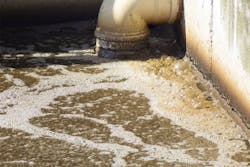Although every application is different, there can be considerable similarity between many applications. Interestingly, instrumentation (and other) professionals with experience can often see commonality in applications in diverse industries. Some years ago, our plant used a technology to introduce chemical feeds that was similar to that used to bottom-blow oxygen to refine steel. On a side note, the controls were entirely different for these processes.
Dirty liquid flow, in general, and sludge flow, in particular, are cases in point. Although their properties may be somewhat different (one is a subset of the other), both contain solids suspended in a liquid. As such, certain common items can be considered when selecting an instrument to measure the flow of these streams. It is often helpful to consider attributes of the flowmeter that should be avoided while understanding that special flowmeter designs may be available in the avoided technologies to address these applications.
In general, flowmeters with impulse tubing, moving parts, and surfaces subject to wear are not advisable in these applications. This means differential pressure, positive displacement, thermal, turbine, and variable area technologies (among others) are usually avoided. Flow technologies that are obstruction-less and less subject to wear tend to be more suitable, such as magnetic and ultrasonic flowmeters. Depending on the application, Coriolis mass flowmeters may or may not be subject to wear and plugging.
Every application should be considered as different. However, they may have commonalities that can eliminate some technologies and help focus on the few technologies that promise to be more applicable.
David W. Spitzer is a regular contributor to Flow Control magazine and a principal in Spitzer and Boyes LLC offering engineering; seminars; strategic marketing consulting; distribution consulting; and expert witness services for manufacturing and automation companies. Spitzer and Boyes is also the publisher of the Industrial Automation INSIDER. Spitzer has more than 40 years of experience and has written more than 10 books and 300 articles about flow measurement, instrumentation and process control. He may be reached at 845-623-1830 or at spitzerandboyes.com.


